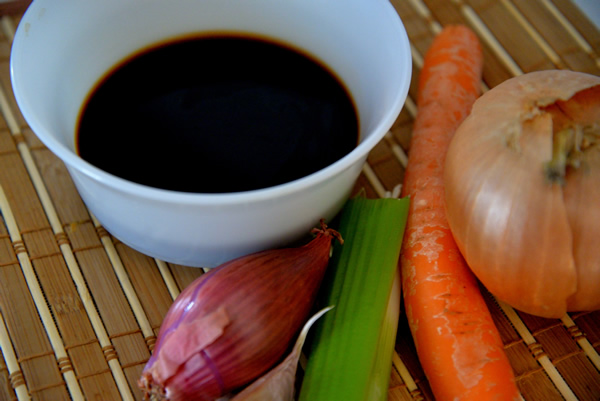Beef Broth

We no longer make beef stock. We make beef broth instead! Yes, we buck the advice of all of the world's great chefs who will tell you that first you make a beef stock and then you turn that into a beef broth, if that's what you want. We take the approach that we want a beef broth to use in our recipes, not a beef stock.
When we make a soup or entrée that calls for beef stock we use our beef broth. We know what it will taste like when it is added to the recipe and we believe it's what makes our beef stock based soups so good! It really enhances the flavour of our pot roasts and stews.
For clarification, the basic difference between a beef stock and a beef broth is:
A beef stock cannot be used as it is, it requires additional seasoning, if nothing else, salt.
A beef broth can be used as is; as a consommé (the broth may require some additional clarifying to turn it into a true consommé) or just as a hot drink, without adding anything more to it.
We also do not agree with the roasting of the marrow bones in the oven before placing them in the stock pot. We do however, brown the marrow bones in the stock pot. When they are roasted in the oven a substantial amount of the brown bits, the fond, is left behind on the aluminum foil or bottom of the roasting pan or tray. When you brown the bones in the stock pot, all of the fond is left behind in the pot, hence more flavour! It also means that there is less to clean-up.
Besides adding some vegetables, herbs and spices to the pot there is no more work in making a beef broth than there is in making a beef stock.
After it is cooked we strain it through a fine mesh sieve and then strain it for a second time through some cheese cloth. We tried to strain it through the cheese cloth initially but it clogs up very quickly.
You can always substitute dry herbs for fresh herbs or vice versa. The formula is 1 teaspoon of dried herbs for every 1 tablespoon of fresh herbs. In other words, use three times as much fresh herbs when the recipe calls for dried and one-third of the amount of dried herbs when the recipe calls for fresh.
We don't peel the carrot, but we wash it and cut the bottom and top off.
Ingredients
- 3 tbsp vegetable oil (we use peanut oil)
- 3 to 3 1/2 lbs of beef soup (marrow) bones
- 1 beef shank (1 to 1 1/2 lbs)
- 10 oz sweet apple cider (our secret ingredient)
- 1 medium yellow onion, top & root end removed, cut into quarters
- 4 small celery stocks (from the celery heart) with the leaves, coarsely chopped
- 1 large carrot, coarsely chopped
- 1 leek, green part, coarsely chopped
- 1 shallot top & root end removed, cut in half
- 3 large garlic cloves, smashed
- 1/2 tbsp dried thyme leaves
- 1/2 tsp dried oregano
- 1/2 tsp dried rosemary
- 1/2 tsp Italian spice blend
- 3 cloves
- 3 tbsp Himalayan fine rock salt
- 8 black peppercorns
- 2 dried bay leaves
- 1 1/2 tsp brown sugar
- 1 1/2 tsp Worcestershire sauce
- 1 1/2 tsp tomato paste (quality)
Directions
- Add 2 tbsp of the oil to an 8 qt soup pot.
- Add the soup bones and brown on all sides (about 3 minutes a side). This may have to be done in batches depending on the physical size of the bones.
- Once all the bones are browned remove them from the pot and set them aside. Add the remaining tbsp of oil to the pot and brown the beef shank on both sides.
- Add the browned soup bones back to the pot with all the other ingredients.
- Add cold water to 1" from the pot brim.
- Bring to a boil, cover and reduce heat to a very low simmer. Simmer for 2 1/2 hours.
- You can skim the surface of the beef broth to remove any scum that may be floating on the surface. We strain our beef broth through cheese cloth, when it is finished cooking, and before we use it in any recipes, so we don't necessarily bother skimming the top of the soup while it is cooking.
- Remove the beef shank. If the bone is still attached to the shank remove it and place the bone back in the pot. Reserve the meat from the beef shank in the refrigerator or freezer as appropriate for later use.
- Continue simmering the beef broth for another 6 to 8 hours.
- Remove lid. Using a spider strainer remove and discard all of the solids. Then pour the remaining liquid through a fine mesh strainer.
- Refrigerate the broth overnight. The next day remove the layer of beef fat that has formed on the top of the broth. Some people save the fat and use it for cooking. We don't.
- Bring the broth to a simmer. Then pour it through a layer of food grade cheese cloth. The beef broth is now ready!
- We take the finished beef broth and boil it down so that it is concentrated, about 4 to 1. We then freeze it in small mason jars.
